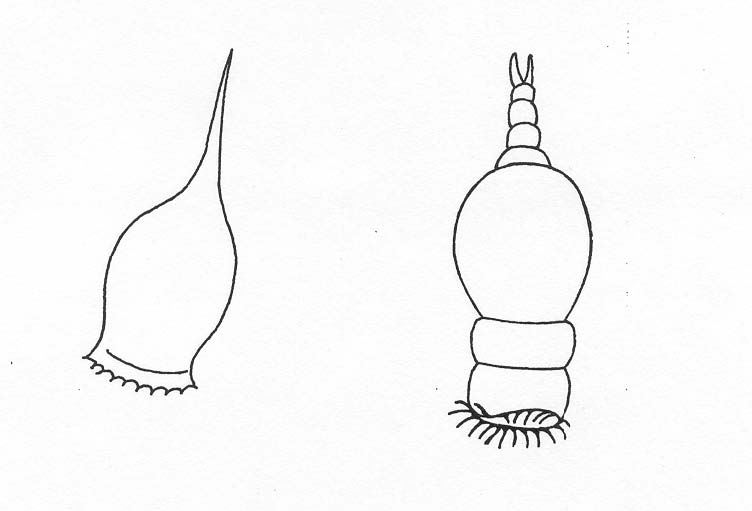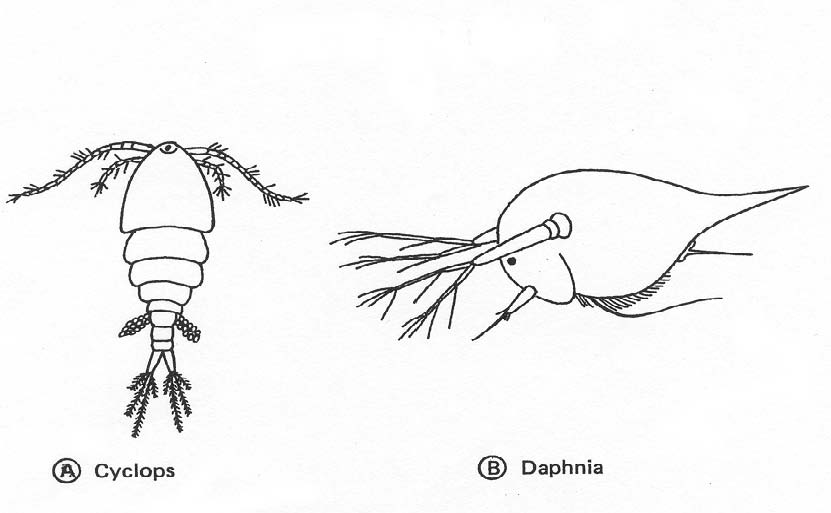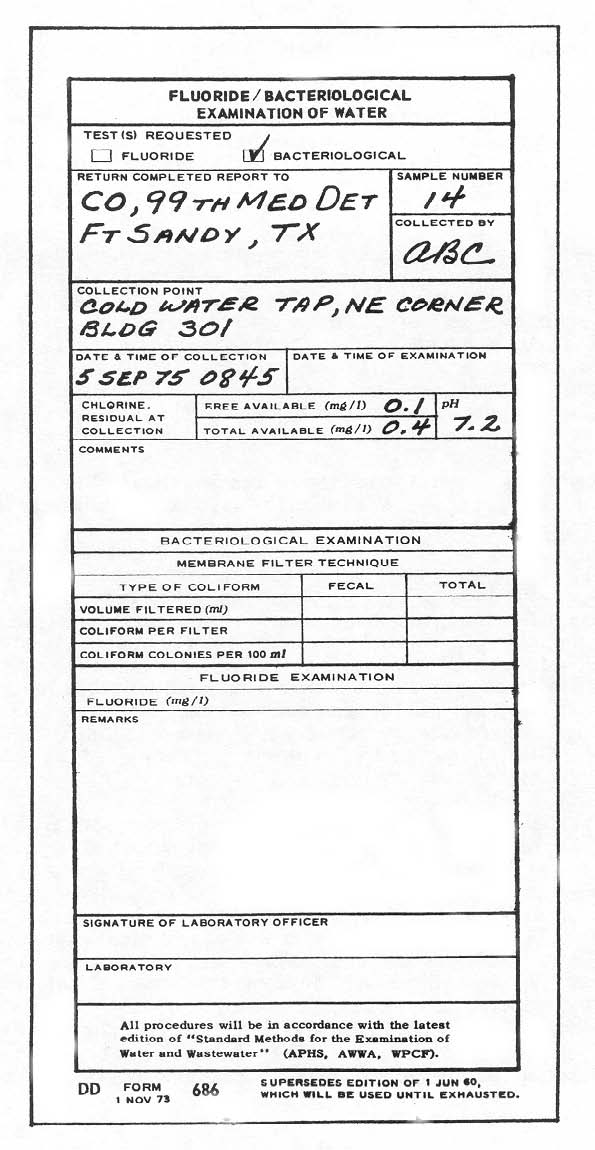Principles of Epidemiology and Microbiology
Lesson 3: Practical Application of Microbiology
Section I: Microbiology of Water and Sewage
3-1
Section I. MICROBIOLOGY OF WATER AND SEWAGE
3-1. INTRODUCTION
a. General. Water is probably man's most precious commodity. Without water, no living organism can exist. Manís health and comfort are dependent upon a safe and palatable water supply. Pure water is seldom found in the natural state. Virtually all water that is available in sufficient quantity for man's needs contains impurities. Most of these impurities are harmless, although they may affect the appearance and palatability of the water. Natural occurring water may contain any of the following impurities:
(1) Inorganic chemicals--primarily metals, metallic salts, and gases.
(2) Suspended solids:
(a) Silt and nonliving organic matter.
(b) Plant life.
(c) Animal life.
b. Plant Life. In addition to the microorganisms previously discussed in this chapter--viruses, bacteria, and fungi--the plant forms known as algae are of interest to the sanitary microbiologist. Algae are those microscopic plants--both unicellular and multicellular--which have chlorophyll but no stems or leaves. They are important in water microbiology because they impart tastes, odors, colors, and turbidity to water.
c. Animal Life. The animal microorganisms of concern to sanitary microbiologist are protozoa, rotifers, crustaceans, and helminthes.
(1) Rotifers. Rotifers are among the simplest of multicellular animals. The rotifer gets its name from two sets of cilia at one end that gives the appearance of two contra rotating wheels (figure 3-1). The cilia are dual purpose--for mobility and food catching. The rotifer's chief source of food is bacteria. It is a strict aerobe and is found only in water that contains low organic content and sufficient dissolved oxygen for respiration. This is a good indication that the water is low in pollution.
(2) Crustaceans. Most crustaceans, such as crayfish and lobsters, are macroscopic (visible with the naked eye); however, some are microscopic. Two crustaceans of interest to the sanitary microbiologist are Daphnia and Cyclops (figure 3-2). They feed on algae and bacteria and are an important source of food for
fish. Because they are strict aerobes, they are also indicators of relatively stable streams or lakes. Crustaceans have been used to reduce the level of algae in bodied or water.
Figure 3-1. Rotifera.
Figure 3-2. Microscopic crustaceans.
d. Potability. Nuclear, biological, and chemical potable water is that which is free of disease-producing organisms, agents, and toxic chemicals. The sanitary microbiologist is concerned with the presence of pathogenic organisms in water. Unfortunately, specific pathogens are not readily detected or identified by
normal bacteriological techniques. Therefore, rather than look for specific' pathogens, the sanitary microbiologist looks for indicator organisms which will indicate the probability that pathogens exist in water. Bacteria of the genera Escherichia and Enterobacter, known as coliform bacteria, are readily identified by their ability to ferment lactose, with the production of gas (subsequently confirmed by other tests). Since Escherichia and Enterobacter are normal inhabitants of the human intestinal tract, their presence in water is considered prima facie evidence of fecal contamination. Diseases such as cholera, typhoid fever, shigellosis, amebic dysentery, and various helminthic infestations are known to be transmitted through water contaminated with infected human feces. Therefore, the presence of coliform bacteria in water is considered a strong possibility that pathogenic organisms are also present. Accordingly, water that shows the presence of coliforms is not considered potable until it has been treated by disinfection (chlorination).
e. Sampling. Bacteriological tests should be made whenever a new source of water is proposed and should be conducted periodically on all existing sources.
(1) Frequency and distribution of samples. TB MED 576, Sanitary Control and Surveillance of Water Supplies at Fixed Installations, prescribes that a minimum of eight monthly samples for coliform determination will be collected at each fixed installation. If the population served is greater than 1,000, an additional sample for 1,000 people will be collected. Sampling points must be representative of the entire installation, and one-fourth of the samples are to be collected each week, so that during the month all points will be progressively covered. Sampling points must be of water distributed for drinking and culinary purposes (that is, dining facilities, hospitals, barracks, and so forth.)
(2) Sample bottles. Bottles used for bacteriological samples may be of any suitable size and shape, but wide-mouthed, ground glass stoppered bottles, of borosylicate glass or polypropylene, are preferred. Metal or plastic screw cap closures may be used provided they are capable of withstanding sterilization without producing toxic or bacteriostatic compounds, or without losing their original configuration and watertight seal. Sample bottles must be thoroughly washed, rinsed in clean (preferably distilled) water enough times to insure the removal of any residual washing compound or detergent, and sterilized by one of the methods described in paragraphs 3-4 and 3-5. The stopper and neck of the bottle are covered with a hood prior to sterilization. Each sample bottle is submitted to the laboratory accompanied by DD Form 686 (Bacteriological Examination of Water) (figure 3-3).
Figure 3-3. DD Form 686 (Bacteriological Examination of Water)
(3) Dechlorination. If the sample to be examined is from a chlorinated water supply, a dechlorinating agent should be added to the sample bottle prior to collecting the sample, in order to stop the bactericidal action of the chlorine and thus give a more accurate indication of the true bacterial content of the sample. Sodium thiosulfate, in an amount sufficient to provide a concentration of 100 mg/1 (0.1 ml of a 10 percent solution of sodium thiosulfate to a 4-oz (118.28 ml) sample bottle), is a satisfactory dechlorinating agent. The sodium thiosulfate must be added prior to sterilization. It is imperative the samples intended for bacteriological examination be delivered or shipped to reach the laboratory with 6 hours after collection. This is important because of the extensive changes that may take place in the bacterial flora even though the samples are stored at temperatures as low as 10ļC. (See paragraph 3-4c)
(4) Procedure. The sample bottle must be kept closed until the moment at which the sample is taken. The stopper and hood are removed in such a manner as to prevent contamination, and the bottle is held near the base. The bottle is filled (leaving an ample air space to facilitate mixing of the sample by shaking) without rinsing and the stopper and hood replaced immediately. The following special procedures apply to specific types of samples.
(a) If the water sample is being taken from a tap, the tap should be connected to a service line from a main, rather than from a storage tank. The tap water should be allowed to run for 2-3 minutes before taking the sample.
(b) If the sample is taken from a well serviced by a pump, the pump should be operated at least long enough for all water to be flushed from the connecting pipes.
(c) Samples taken from rivers, streams, lakes, reservoirs, or other surface sources should be collected at a point which is representative of the water which will be the source of supply to the consumer. Particular caution should be taken not to disturb the bank of a pond or stream; otherwise, fouling of the water may occur and the sample will not be representative. The bottle should be held near the base and plunged, neck downward, below the surface. The bottle is then turned so that the neck points slightly upward and toward the current. If there is no current, one may be created by pushing the bottle, underwater, in the direction of the mouth.




